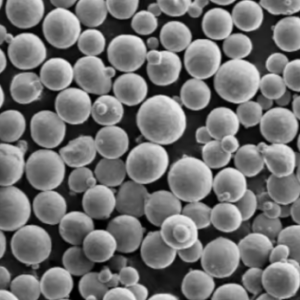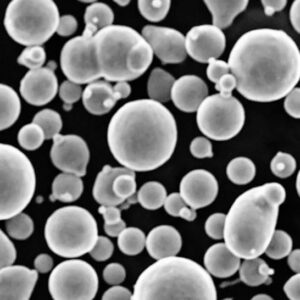전자 빔 적층 제조(EBAM) 는 금속 제조의 세계를 혁신하고 있습니다. 전자빔을 사용하여 금속 분말이나 와이어를 융합하여 금속 부품을 층층이 쌓아 올리는 공정을 상상해 보세요. 미래지향적으로 들리죠? 더 이상 공상 과학 소설 속 이야기가 아닙니다. 지금 이 순간에도 일어나고 있으며, 제조에 대한 우리의 생각을 바꾸고 있습니다.
전자 빔 적층 제조(EBAM) 개요
EBAM은 고에너지 전자빔을 사용하여 금속 분말이나 와이어를 층별로 녹이고 융합하여 복잡한 금속 부품을 만드는 첨단 제조 기술입니다. 이 공정은 기존 제조 방식에 비해 복잡한 형상의 부품을 만들 수 있고, 재료 낭비를 줄이며, 생산 시간을 단축하는 등 다양한 이점을 제공합니다. 하지만 이는 표면적인 장점에 불과합니다.
EBAM의 주요 세부 정보
- 기술: 전자 빔을 사용하여 금속 분말이나 와이어를 녹이고 융합합니다.
- 재료: 주로 다양한 금속 분말 및 와이어와 함께 사용됩니다.
- 애플리케이션: 항공우주, 자동차, 의료용 임플란트 등.
- 혜택: 높은 정밀도, 낭비 감소, 생산 시간 단축.

EBAM에 사용되는 금속 분말의 종류
EBAM에는 각각 고유한 특성과 용도를 가진 다양한 유형의 금속 분말이 사용됩니다. 다음은 10가지 구체적인 모델입니다:
| 금속 분말 | 구성 | 속성 | 애플리케이션 |
|---|---|---|---|
| Ti-6Al-4V | 6% Al 및 4% V의 티타늄 합금 | 고강도, 내식성 | 항공우주, 의료용 임플란트 |
| 인코넬 718 | 니켈-크롬 합금 | 고온 내성 | 터빈 블레이드, 항공우주 부품 |
| 스테인리스 스틸 316L | 16-18% Cr 및 10-14% Ni의 철 합금 | 내식성, 내구성 | 의료 기기, 식품 가공 장비 |
| AlSi10Mg | 10% Si 및 0.3% Mg의 알루미늄 합금 | 가볍고 우수한 열 전도성 | 자동차 부품, 열교환기 |
| 구리(Cu) | 순수 구리 | 뛰어난 전기 전도성 | 전기 부품, 방열판 |
| 하스텔로이 X | 니켈 기반 초합금 | 고온에서의 내산화성 | 가스터빈, 화학 처리 |
| 마레이징 스틸(18Ni300) | 철-니켈 합금(18% Ni 및 8-12% Co) | 높은 강도, 경도 | 툴링, 항공우주 부품 |
| CoCrMo | 코발트-크롬-몰리브덴 합금 | 내마모성, 생체 적합성 | 의료용 임플란트, 치과용 애플리케이션 |
| Ti-6Al-2Sn-4Zr-6Mo | 6% Al, 2% Sn, 4% Zr, 6% Mo가 포함된 티타늄 합금 | 고강도, 내피로성 | 항공우주 부품, 고응력 부품 |
| 알루미늄 6061 | 마그네슘 및 Si가 포함된 알루미늄 합금 | 가볍고 다양한 활용성 | 구조 부품, 해양 애플리케이션 |
EBAM 금속 분말의 구성
EBAM에 사용되는 금속 분말의 구성을 이해하는 것은 매우 중요합니다. 이러한 분말은 제조 공정의 특정 요구 사항을 충족하도록 세심하게 설계되었습니다.
| 금속 분말 | 주요 요소 | 마이너 요소 |
|---|---|---|
| Ti-6Al-4V | 티타늄, 알루미늄, 바나듐 | 산소, 질소, 탄소 |
| 인코넬 718 | 니켈, 크롬, 철 | 몰리브덴, 니오븀, 알루미늄, 티타늄 |
| 스테인리스 스틸 316L | 철, 크롬, 니켈 | 몰리브덴, 망간, 실리콘 |
| AlSi10Mg | 알루미늄, 실리콘, 마그네슘 | 철, 구리, 망간 |
| 구리(Cu) | 구리 | 산소, 인 |
| 하스텔로이 X | 니켈, 크롬, 철 | 몰리브덴, 코발트, 텅스텐 |
| 마레이징 스틸(18Ni300) | 철, 니켈, 코발트 | 몰리브덴, 티타늄, 알루미늄 |
| CoCrMo | 코발트, 크롬, 몰리브덴 | 니켈, 철, 탄소 |
| Ti-6Al-2Sn-4Zr-6Mo | 티타늄, 알루미늄, 주석, 지르코늄, 몰리브덴 | 산소, 철, 실리콘 |
| 알루미늄 6061 | 알루미늄, 마그네슘, 실리콘 | 철, 구리, 아연 |
EBAM 금속 분말의 특성
EBAM에 사용되는 금속 분말의 특성은 그 구성만큼이나 중요합니다. 이러한 특성은 제조 공정과 최종 제품에서 재료가 어떻게 작동할지를 결정합니다.
| 특성 | 설명 |
|---|---|
| 입자 크기 | 일반적으로 15~150미크론 범위 |
| 유동성 | 일관된 분말 분배를 위한 필수 요소 |
| 순도 | 재료 무결성을 보장하는 고순도 수준 |
| 밀도 | 용융 및 응고 과정에 영향을 미칩니다. |
| 산화 저항 | 재료 특성 유지에 중요 |
응용 프로그램 전자 빔 적층 제조(EBAM)
EBAM은 항공우주 부품부터 의료용 임플란트에 이르기까지 다양한 분야에 사용됩니다. 복잡한 형상을 만들고 고성능 재료를 사용할 수 있기 때문에 정밀도와 성능이 중요한 산업에 이상적입니다.
| 산업 | 애플리케이션 |
|---|---|
| 항공우주 | 터빈 블레이드, 구조 부품, 엔진 부품 |
| 자동차 | 경량 부품, 프로토타입, 맞춤형 구성 요소 |
| 의료 | 임플란트, 보철물, 수술 도구 |
| 에너지 | 터빈 부품, 열교환기, 연료 전지 |
| 툴링 | 맞춤형 금형, 금형 및 지그 |
| 방어 | 갑옷, 무기 부품, 특수 장비 |
| 전자 제품 | 방열판, 커넥터, 케이스 |
EBAM의 사양, 크기, 등급 및 표준
EBAM으로 작업할 때는 최종 제품의 품질과 성능을 보장하기 위해 특정 표준과 사양을 준수하는 것이 필수적입니다.
| 금속 분말 | 크기 | 성적 | 표준 |
|---|---|---|---|
| Ti-6Al-4V | 15-45 µm, 45-90 µm | 5학년 | ASTM F2924, AMS 4998 |
| 인코넬 718 | 15-45 µm, 45-106 µm | AMS 5662, AMS 5663 | ASTM B637 |
| 스테인리스 스틸 316L | 15-45 µm, 45-90 µm | 316L | ASTM A276, ASTM F138 |
| AlSi10Mg | 15-45 µm, 45-106 µm | – | ASTM B928, EN 1706 |
| 구리(Cu) | 15-45 µm, 45-106 µm | C11000 | ASTM B170 |
| 하스텔로이 X | 15-45 µm, 45-90 µm | AMS 5754 | ASTM B619 |
| 마레이징 스틸(18Ni300) | 15-45 µm, 45-90 µm | – | ASTM A538 |
| CoCrMo | 15-45 µm, 45-90 µm | ASTM F75 | ISO 5832-4 |
| Ti-6Al-2Sn-4Zr-6Mo | 15-45 µm, 45-106 µm | – | AMS 4919 |
| 알루미늄 6061 | 15-45 µm, 45-90 µm | 6061-T6 | ASTM B209, ASTM B221 |
EBAM 금속 분말의 공급업체 및 가격 세부 정보
제조 공정에 EBAM을 활용하려는 기업에게는 신뢰할 수 있는 공급업체를 찾고 가격을 이해하는 것이 중요합니다.
| 공급업체 | 금속 분말 | 가격 범위(kg당) |
|---|---|---|
| EOS GmbH | Ti-6Al-4V, 인코넬 718, 스테인리스 스틸 316L | $300 – $500 |
| 카펜터 기술 | AlSi10Mg, 구리, 하스텔로이 X | $250 – $600 |
| 회가나스 AB | 마징강, CoCrMo, Ti-6Al-2Sn-4Zr-6Mo | $200 – $700 |
| GKN 첨가제 | 알루미늄 6061, 인코넬 718, 스테인리스 스틸 316L | $300 – $550 |
| AP&C(Arcam) | Ti-6Al-4V, 인코넬718, AlSi10Mg 718, AlSi10Mg | $350 – $650 |
| LPW 기술 | 구리, 하스텔로이 X, 마레이징 스틸 | $250 – $600 |
| 샌드빅 | Ti-6Al-2Sn-4Zr-6Mo, CoCrMo, 스테인리스 스틸 316L | $200 – $700 |
| 프렉스에어 | 인코넬 718, 알루미늄 6061, Ti-6Al-4V | $300 – $600 |
| 금속 분석 | Ti-6Al-4V, 하스텔로이 X, AlSi10Mg | $250 – $650 |
| ATI 금속 | 스테인리스 스틸 316L, 구리, 인코넬 718 | $300 – $550 |
EBAM의 장단점 비교
EBAM을 고려할 때는 다른 제조 방법과 비교하여 장점과 한계를 비교하는 것이 중요합니다.
| 측면 | 장점 | 제한 사항 |
|---|---|---|
| 정밀도 | 고정밀, 복잡한 형상 생성 가능 | 세심한 보정 및 제어가 필요합니다. |
| 재료 효율성 | 빼기 방식에 비해 낭비 최소화 | 분말 처리 및 재활용은 어려울 수 있습니다. |
| 속도 | 특정 부품의 생산 시간 단축 | 초기 설정 및 보정에는 많은 시간이 소요될 수 있습니다. |
| 머티리얼 속성 | 우수한 기계적 특성, 높은 강도 | 전자빔으로 가공할 수 있는 재료로 제한됩니다. |
| 비용 | 소량 배치 및 맞춤형 부품에 비용 효율적 | 장비 및 자재에 대한 높은 초기 투자 비용 |
| 유연성 | 맞춤형 및 일회성 부품을 쉽게 제작할 수 있습니다. | 기존 방식에 비해 대량 생산에 적합하지 않음 |
| 포스트 프로세싱 | 최소한의 후처리가 필요한 경우가 많습니다. | 일부 부품은 용도에 따라 추가 마감이 필요할 수 있습니다. |

자주 묻는 질문
이 혁신적인 기술을 더 잘 이해하는 데 도움이 되는 EBAM에 대해 자주 묻는 질문 몇 가지를 소개합니다.
| 질문 | 답변 |
|---|---|
| EBAM이란 무엇인가요? | 전자 빔 적층 제조는 전자 빔을 사용하여 금속 분말이나 와이어를 녹이고 융합하여 부품을 층별로 만드는 공정입니다. |
| EBAM에서 사용할 수 있는 자료는 무엇인가요? | 티타늄 합금, 니켈 합금, 스테인리스강, 알루미늄 합금 등 다양한 금속 분말과 와이어를 사용할 수 있습니다. |
| EBAM의 장점은 무엇인가요? | 높은 정밀도, 재료 낭비 감소, 생산 시간 단축, 복잡한 형상을 만들 수 있습니다. |
| EBAM의 한계는 무엇인가요? | 초기 투자 비용이 높고, 세심한 보정이 필요하며, 전자빔으로 처리할 수 있는 재료로 제한됩니다. |
| 어떤 산업에서 EBAM을 사용하나요? | 항공우주, 자동차, 의료, 에너지, 툴링, 방위 및 전자 제품. |
| EBAM은 다른 3D 프린팅 방법과 어떻게 다른가요? | EBAM은 우수한 기계적 특성을 제공하며 고성능 애플리케이션에 적합하지만 설치 비용이 더 비싸고 복잡할 수 있습니다. |
| EBAM에 사용되는 일반적인 금속 분말에는 어떤 것이 있나요? | Ti-6Al-4V, 인코넬 718, 스테인리스 스틸 316L, AlSi10Mg, 구리, 하스텔로이 X, 마레이징 스틸, CoCrMo, Ti-6Al-2Sn-4Zr-6Mo 및 알루미늄 6061. |
| EBAM 부품에 포스트 프로세싱이 필요합니까? | EBAM 부품은 최소한의 후처리가 필요한 경우가 많지만, 일부 애플리케이션에는 추가 마감이 필요할 수 있습니다. |
| EBAM에서 전자빔은 어떻게 작동하나요? | 전자빔은 열을 발생시켜 금속 분말이나 와이어를 층별로 녹이고 융합하여 부품을 제작합니다. |
| EBAM의 미래는 어떻게 될까요? | 재료, 공정 최적화, 다양한 산업 분야의 응용 분야가 지속적으로 발전하고 있는 EBAM의 미래는 유망해 보입니다. |
결론
전자 빔 적층 제조(EBAM) 은 제조업에 대한 생각을 바꾸는 획기적인 기술입니다. 고에너지 전자 빔을 활용하여 금속 분말이나 와이어를 녹이고 융합하는 EBAM은 낭비를 최소화하고 생산 시간을 단축하면서 복잡한 고성능 부품을 만들 수 있습니다. 항공우주, 자동차, 의료 등 정밀도와 성능이 요구되는 모든 산업 분야에서 EBAM은 매력적인 솔루션을 제공합니다. 그렇다면 EBAM의 가능성을 살펴보고 제조 공정을 혁신할 수 있는 방법을 알아보는 것은 어떨까요?














